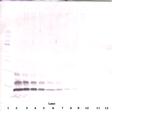Search Thermo Fisher Scientific
图: 1 / 3
CCL4 Antibody (500-P38BBT-25UG) in WB



产品信息
500-P38BBT-25UG
种属反应
宿主/亚型
分类
类型
抗原
偶联物
形式
浓度
纯化类型
保存液
内含物
保存条件
运输条件
RRID
产品详细信息
AA Sequence of recombinant protein: APMGSDPPTA CCFSYTARKL PHNFVVDYYE TSSLCSQPAV VFQTKRGKQV CADPSESWVQ EYVYDLELN.
Preparation: Produced from sera of rabbits immunized with highly pure Recombinant Human MIP-1beta (CCL4). Anti-Human MIP-1beta (CCL4)-specific antibody was purified by affinity chromatography and then biotinylated.
Sandwich ELISA: To detect Human MIP-1beta by sandwich ELISA (using 100 µL/well antibody solution) a concentration of 0.25-1.0 µg/mL of this antibody is required. This biotinylated polyclonal antibody, in conjunction with PeproTech Polyclonal Anti-Human MIP-1beta (500-P38B) as a capture antibody, allows the detection of at least 0.2-0.4 ng/well of Recombinant Human MIP-1beta.
Western Blot: To detect Human MIP-1beta by Western Blot analysis this antibody can be used at a concentration of 0.1-0.2 µg/mL. When used in conjunction with compatible secondary reagents, the detection limit for Recombinant Human MIP-1beta is 1.5-3.0 ng/lane, under either reducing or non-reducing conditions.
500-P38BBT-1MG will be provided as 2 x 500 µg
靶标信息
CCL4 (macrophage inflammatory protein 1-beta, MIP1B) belongs to the intercrine beta (chemokine CC) family. Functionally, CCL4 is involved in chemotactic and proinflammatory effects, and homeostasis. CCL4 is produced by macrophages upon stimulation by bacterial endotoxins. CCL4 recruits and stimulates various inflammatory cells at sites of inflammation. CCL4 is produced by lymphocytes, macrophages and dendritic cells. Both CCL4 and the related protein CCL3 participate in the host response to invading bacterial, viral, parasite and fungal pathogens by regulating the trafficking and activation state of selected subgroups of inflammatory cells. While both CCL4 and CCL3 exert similar effects on monocytes, their effect on lymphocytes differ, with CCL4 selectively attracting CD4+ lymphocytes and CCL3 selectively attracting CD8+ lymphocytes. Additionally, both have been shown to be potent chemoattractants for B cells, eosinophils and dendritic cells. The processed form of CCL4 can induce down-modulation of surface expression of the chemokine receptor CCR5, thus inhibiting the CCR5-mediated entry of HIV-1 in T cells. CCL4 binds with high affinity to CCR5 receptors.
仅用于科研。不用于诊断过程。未经明确授权不得转售。
篇参考文献 (0)
生物信息学
蛋白别名: ACT-2; C-C motif chemokine 4; chemokine (C-C motif) ligand 4; G-26 T-lymphocyte-secreted protein; HC21; LAG-1; Lymphocyte activation gene 1 protein; Macrophage inflammatory protein 1-beta; MGC104418; MGC126025; MGC126026; MIP-1-beta; MIP-1-beta(1-69); MIP1-beta; MIP1beta; PAT 744; Protein H400; RP23-320E6.8; secreted protein G-26; SIS-gamma; small inducible cytokine A4 (homologous to mouse Mip-1b); Small-inducible cytokine A4; T-cell activation protein 2
基因别名: ACT2; AT744.1; CCL4; G-26; HC21; LAG-1; LAG1; MIP-1-beta; MIP1B; MIP1B1; SCYA2; SCYA4
UniProt ID: (Human) P13236
Entrez Gene ID: (Human) 6351



